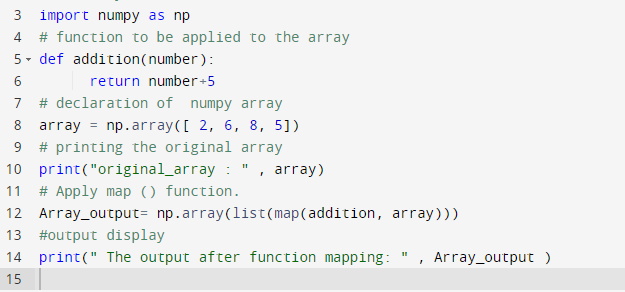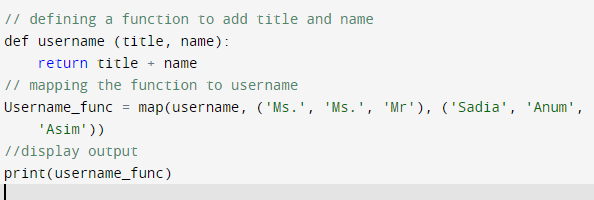NumPy Map
Procedure:
This article follows certain steps to complete the implementation of the Map() function. The first step right after the introduction is the detailed information on the syntax of this function where we learn about the parameters of the function. Then, we solve some examples to perform the mapping on various lists and arrays.
Syntax:
While using any function, we should know about its parameters so that we can take the most out of that function in terms of the output without facing any syntax errors and succeed with the function in the very first go. As we learned in the introduction that the NumPy function applies a function on the elements of lists/arrays, this function takes in the two parameters to work properly. The one parameter from the two parameters is the “function name” that we want to apply on an array. The second parameter is the “iterable name” which takes the name of the list or the array/iterable on which we want to apply the function. This syntax is written in the intact form in the following line:
Return Value:
The function returns the output as the updated lists/array after the application of the certain function on the original list/array.
Example 1:
Let’s write a Python code for the practical demonstration of the NumPy map() function based on the syntax that we just learned. We begin the implementation of this example by preparing our compilers first to start writing the code in it for execution. First, open the compilers and create a project in it. Then, save it in the desired directory in the systems. Now, import the “Numpy” library which we use to implement our function. We import this package as “np” so that this np is called in the code as a substitute for NumPy.
Move forward and create an array on which we perform the map function. For this purpose, we call the “np. array ([elements of the array])” method. Initialize the array with the random elements as “[ 2, 6, 8]”. For mapping, we define a function with the name “addition” that has the “number” parameter and returns the sum of this number with another number like “5”. Now, to map this addition function on the elements of the array, we use the call method of the NumPy map() function as “np. map (function_name, array)”. We pass on the “addition” as function_name and “array” as an array to the parameters of this map function. We have given a Python program that we can copy and execute to check for the output of the function.


The map function returned the output as the updated version of the array after applying the addition function to the original array.
Example 2:
Suppose we have a list that contains the names of the people, and based on the names, we have to give the titles to the name as “Mr. or Ms.“ This can be done simply using the “NumPy map()” function. To initialize the example, we import the required “NumPy” library. Then, from the library, we import the NumPy module as “np”. After importing NumPy, we create a list having the names “[“Sadia”, “Anum“, “Asim”]” and the titles as “ [“Ms.”, “Ms.”, “Mr.”]. We define a function with the name “username” which takes two parameters as “Title” and “Name”. The return value of this function is defined as that it adds the “Title+Name” . We now apply this function on the lists that we created as title and name, calling the function as “map ( user, Title, Name)”. The mapping is in a way that it returns the combination of a name with the title as we defined in the “username” function.


We have got several ways to write this example using the NumPy map function. But in this example, we write the code with the simplest method where we pass the map() function with the name of the function which adds the title and name and the two other arguments that will be the lists having the names and the titles. The program to implement this example is given in the previous figure and the output is also displayed which is the list with the names and the titles.
Conclusion
We covered all the necessary information from the introduction to the syntax and the practical demonstration on how to implement this function in the Python programming language. We have seen two different examples where the first one explains how to add a number to the elements of the array and the second shows how to add the title to the list of names. The code is implemented in the Spyder Ide of the Python platform which is an open-source environment for Python.
Source: linuxhint.com
